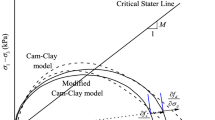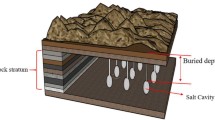Abstract
Atangana–Baleanu (AB) fractional derivative solves some outstanding problems in the field of fractional differentiation because of its nonsingular and nonlocal kernel characteristics. It also provides a new research direction for the application of fractional derivatives in the constitutive modeling of rock and soil materials. In this paper, we propose a new AB fractional-order dashpot and use it in a comparative study. We find that the new dashpot has the capability to capture the memory effect of the traditional Riemann–Liouville (RL) fractional-order dashpot. It can also describe the viscoelastic behavior of materials as a function of time. By replacing the Newtonian dashpot with the AB fractional-order dashpot in the Nishihara model, we establish a new AB fractional-derivative (ABFD) creep model. We analytically solve the ABFD creep model by the Laplace transform. The fitting results for the experimental data obtained for rock salt creep show that the ABFD creep model provides a better fitting capability than the Nishihara model and Riemann–Liouville (RL) fractional-derivative model.







Similar content being viewed by others
Data Availability
Data will be made available on reasonable request.
References
Ali, A.K., Khan, I., Soopy, N.K., et al.: Effects of carbon nanotubes on magnetohydrodynamic flow of methanol based nanofluids via Atangana–Baleanu and Caputo–Fabrizio fractional derivatives. Therm. Sci. 23(2 Part B), 883–898 (2019). https://doi.org/10.2298/tsci180116165a
Anderson, D.R., Ulness, D.J.: Properties of the Katugampola fractional derivative with potential application in quantum mechanics. J. Math. Phys. 56(6), 063502 (2015). https://doi.org/10.1063/1.4922018
Asamoah, J.K.K.: Fractal-fractional model and numerical scheme based on Newton polynomial for Q fever disease under Atangana–Baleanu derivative. Results Phys. 34, 105189 (2022). https://doi.org/10.1016/j.rinp.2022.105189
Atangana, A., Baleanu, D.: New fractional derivatives with nonlocal and non-singular kernel: theory and application to heat transfer model. (2016) https://doi.org/10.2298/TSCI160111018A. ar**v preprint 1602.03408
Atangana, A., Koca, I.: Chaos in a simple nonlinear system with Atangana–Baleanu derivatives with fractional order. Chaos Solitons Fractals 89, 447–454 (2016). https://doi.org/10.1016/j.chaos.2016.02.012
Bin-Mohsin, B.: Some new solutions of the conformable extended Zakharov–Kuznetsov equation using Atangana–Baleanu conformable derivative. Therm. Sci. 23(Suppl. 6), 2127–2137 (2019). https://doi.org/10.2298/TSCI190303402B
Birs, I., Muresan, C., Prodan, O., et al.: An experimental approach towards motion modeling and control of a vehicle transiting a non-Newtonian environment. Fractal Fract. 5(3), 104 (2021). https://doi.org/10.3390/fractalfract5030104
Blair, G.S.: The role of psychophysics in rheology. J. Colloid Sci. 2(1), 21–32 (1947). https://doi.org/10.1016/0095-8522(47)90007-X
Caputo, M.: Linear models of dissipation whose Q is almost frequency independent. Ann. Geophys. 19(4), 383–393 (1966)
Caputo, M.: Linear models of dissipation whose Q is almost frequency independent—II. Geophys. J. Int. 13(5), 529–539 (1967)
Caputo, M.: Elasticita e dissipazione. Zanichelli, Bologna (1969)
Caputo, M., Fabrizio, M.: A new definition of fractional derivative without singular kernel. Prog. Fract. Differ. Appl. 1(2), 73–85 (2015). https://doi.org/10.12785/pfda/010201
Caputo, M., Fabrizio, M.: Applications of new time and spatial fractional derivatives with exponential kernels. Prog. Fract. Differ. Appl. 2(1), 1–11 (2016). https://doi.org/10.18576/pfda/020101
Caputo, M., Mainardi, F.: Linear models of dissipation in anelastic solids. Riv. Nuovo Cimento (1971-1977) 1(2), 161 (1971a). https://doi.org/10.1007/bf02820620
Caputo, M., Mainardi, F.: A new dissipation model based on memory mechanism. Pure Appl. Geophys. 91(1), 134–147 (1971b). https://doi.org/10.1007/BF00879562
Chen, W.: Time-space fabric underlying anomalous diffusion. Chaos Solitons Fractals 28(4), 923–929 (2006). https://doi.org/10.1016/j.chaos.2005.08.199
Connolly, J.A.: The numerical solution of fractional and distributed order differential equations. PhD, University of Liverpool, Liverpool (2004)
Dong, J., Zhang, G.j., **e, Y., et al.: Dynamic behavior analysis of fractional-order Hindmarsh–Rose neuronal model. Cogn. Neurodyn. 8(2), 167–175 (2014). https://doi.org/10.1007/s11571-013-9273-x
Feng, Y.Y., Yang, X.J., Liu, J.G., et al.: A new fractional Nishihara-type model with creep damage considering thermal effect. Eng. Fract. Mech. 242, 107451 (2021). https://doi.org/10.1016/j.engfracmech.2020.107451
Gerasimov, A.N.: A generalization of linear laws of deformation and its application to problems of internal friction. Akad. Nauk SSSR Prikl. Mat. Mekh. 12, 251–260 (1948)
Gómez, F., Bernal, J., Rosales, J., et al.: Modeling and simulation of equivalent circuits in description of biological systems – a fractional calculus approach. J. Electr. Bioimpedance 3(1), 2–11 (2012). https://doi.org/10.5617/jeb.225
Goufo, E.F.D.: Application of the Caputo–Fabrizio fractional derivative without singular kernel to Korteweg–de Vries–Bergers equation. Math. Model. Anal. 21(2), 188–198 (2016). https://doi.org/10.3846/13926292.2016.1145607
Haq, I., Khan, A., Ahmad, S., et al.: Modeling and analysis of a fractional anthroponotic cutaneous leishmania model with Atangana–Baleanu derivative. Comput. Methods Biomech. Biomed. Eng. (2022). https://doi.org/10.1080/10255842.2022.2035372
Hernández-Balaguera, E.: Coulostatics in bioelectrochemistry: a physical interpretation of the electrode-tissue processes from the theory of fractional calculus. Chaos Solitons Fractals 145, 110787 (2021)
Hou, Z.: Untersuchungen zum nachweis der standsicherheit für untertagedeponien im salzgebirge: Papierflieger (1998)
Iqbal, S.A., Hafez, M.G., Chu, Y.-M., et al.: Dynamical analysis of nonautonomous rlc circuit with the absence and presence of Atangana–Baleanu fractional derivative. J. Appl. Anal. Comput. 12(2), 770–789 (2022). https://doi.org/10.11948/20210324
Jarad, F., Abdeljawad, T., Hammouch, Z.: On a class of ordinary differential equations in the frame of Atangana–Baleanu fractional derivative. Chaos Solitons Fractals 117, 16–20 (2018). https://doi.org/10.1016/j.chaos.2018.10.006
Khalil, R., Al Horani, M., Yousef, A., et al.: A new definition of fractional derivative. J. Comput. Appl. Math. 264, 65–70 (2014). https://doi.org/10.1016/j.cam.2014.01.002
Khan, M., Rasheed, A., Anwar, M.S., et al.: Modelling charge carrier transport with anomalous diffusion and heat conduction in amorphous semiconductors using fractional calculus. Phys. Scr. 96(4), 045204 (2021). https://doi.org/10.1088/1402-4896/abde0f
Kilbas, A.A., Srivastava, H.M., Trujillo, J.J.: Theory and Applications of Fractional Differential Equations. Elsevier, Amsterdam (2006)
Li, S., Huang, C., Yuan, S.: Hopf bifurcation of a fractional-order double-ring structured neural network model with multiple communication delays. Nonlinear Dyn. (2022). https://doi.org/10.1007/s11071-021-07177-6
Ma, W., Zhao, Y., Guo, L., et al.: Qualitative and quantitative analysis of the COVID-19 pandemic by a two-side fractional-order compartmental model. ISA Trans. 124, 144–156 (2022). https://doi.org/10.1016/j.isatra.2022.01.008
Nguyen Phuong, D., Hoang Viet, L., Nguyen Long, G.: The fuzzy fractional SIQR model of computer virus propagation in wireless sensor network using Caputo Atangana–Baleanu derivatives. Fuzzy Sets Syst. 429, 28–59 (2022). https://doi.org/10.1016/j.fss.2021.04.012
Nishihara, M.: Creep of shale and sandy-shale. J. Geol. Soc. Jpn. 58(683), 373–377 (1952). https://doi.org/10.5575/geosoc.58.373
Podlubny, I.: Fractional Differential Equations: An Introduction to Fractional Derivatives, Fractional Differential Equations, to Methods of Their Solution and Some of Their Applications. Elsevier, Amsterdam (1998)
Samko, S.G., Kilbas, A.A., Marichev, O.I.: Fractional Integrals and Derivatives: Theory and Applications. Nauka I Tekhnika, Minsk (1993)
Schulze, O., Heemann, U., Zetsche, F., et al.: Comparison of Advanced Constitutive Models for the Mechanical Behavior of Rock Salt – Results from a Joint Research Project – 1. Modeling of Deformation Processes and Benchmark Calculations (2007)
Shaikh, A., Nisar, K.S., Jadhav, V., et al.: Dynamical behaviour of HIV/AIDS model using fractional derivative with Mittag-Leffler kernel. Alex. Eng. J. 61(4), 2601–2610 (2022). https://doi.org/10.1016/j.aej.2021.08.030
Shitikova, M.V.: Fractional Operator Viscoelastic Models in Dynamic Problems of Mechanics of Solids: A Review. Mechanics of Solids (2021). https://doi.org/10.3103/s0025654422010022
Tan, T.K., Kang, W.F.: Locked in stresses, creep and dilatancy of rocks, and constitutive equations. Rock Mech. Rock Eng. 13, 17 (1980). https://doi.org/10.1007/BF01257895
Usman, M., Hamid, M., Khan, Z.H., et al.: Neuronal dynamics and electrophysiology fractional model: a modified wavelet approach. Phys. A, Stat. Mech. Appl. 570, 125805 (2021). https://doi.org/10.1016/j.physa.2021.125805
Wei, Q., Zhou, H., Yang, S.: Non-Darcy flow models in porous media via Atangana–Baleanu derivative. Chaos Solitons Fractals 141, 110335 (2020). https://doi.org/10.1016/j.chaos.2020.110335
Wu, F., Liu, J.F., Wang, J.: An improved Maxwell creep model for rock based on variable-order fractional derivatives. Environ. Earth Sci. 73(11), 6965–6971 (2015). https://doi.org/10.1007/s12665-015-4137-9
Xu, Z., Chen, W.: A fractional-order model on new experiments of linear viscoelastic creep of Hami Melon. Comput. Math. Appl. 66(5), 677–681 (2013). https://doi.org/10.1016/j.camwa.2013.01.033
Yadav, S., Pandey, R.K.: Numerical approximation of fractional Burgers equation with Atangana–Baleanu derivative in Caputo sense. Chaos Solitons Fractals 133, 109630 (2020). https://doi.org/10.1016/j.chaos.2020.109630
Yadav, S., Pandey, R.K., Shukla, A.K.: Numerical approximations of Atangana–Baleanu Caputo derivative and its application. Chaos Solitons Fractals 118, 58–64 (2019). https://doi.org/10.1016/j.chaos.2018.11.009
Yu, M., Liu, B., Sun, J., et al.: Study on improved nonlinear viscoelastic-plastic creep model based on the Nishihara model. Geotech. Geolog. Eng. 38(3), 3203–3214 (2020). https://doi.org/10.1007/s10706-020-01217-5
Zhang, L., Zhou, H., Wang, X., et al.: A triaxial creep model for deep coal considering temperature effect based on fractional derivative. Acta Geotech. (2021). https://doi.org/10.1007/s11440-021-01302-w
Zhou, H.W., Wang, C.P., Han, B.B., et al.: A creep constitutive model for salt rock based on fractional derivatives. Int. J. Rock Mech. Min. Sci. 48(1), 116–121 (2011). https://doi.org/10.1016/j.ijrmms.2010.11.004
Zhou, H., Su, T., Deng, H., et al.: Characterizing three-dimensional creep of Beishan granite by the variable-coefficient Abel dashpot. Mech. Time-Depend. Mater. 25(1), 85–100 (2021). https://doi.org/10.1007/s11043-019-09428-x
Zhu, K.: Some advances in non-Newtonian fluid mechanics. Mech. Eng. (2006). https://doi.org/10.6052/1000-0992-2006-178
Acknowledgements
This work is supported by the National Natural Science Foundation of China (51827901, 52121003, 52142302), the 111 Project (B14006), and the Yueqi Outstanding Scholar Program of CUMTB (2017A03). The financial supports from the Guizhou Department of Education Youth Talent Growth Project of China ([2019]161) and the Bijie Science and Technology Bureau Joint Fund project of China (G[2019]26) are also gratefully acknowledged. The authors would like to express his heartfelt thanks to the anonymous reviewers for their valuable and constructive comments. The reviewer’s suggestions contributed greatly to the improvement of this work.
Author information
Authors and Affiliations
Corresponding author
Ethics declarations
Competing Interests
The authors declare that all authors in this paper have no competing personal relationships or financial interests that could affect the reporting of this paper.
Additional information
Publisher’s Note
Springer Nature remains neutral with regard to jurisdictional claims in published maps and institutional affiliations.
Rights and permissions
About this article
Cite this article
Deng, H., Zhou, H., Wei, Q. et al. A creep constitutive model based on Atangana–Baleanu fractional derivative. Mech Time-Depend Mater 27, 1171–1186 (2023). https://doi.org/10.1007/s11043-022-09560-1
Received:
Accepted:
Published:
Issue Date:
DOI: https://doi.org/10.1007/s11043-022-09560-1




